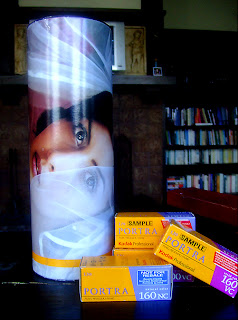Don't abandon hope yet!
I know a number of us participated in Kodak's film give-away when their new Porta film was introduced.
The 20,000 rolls that Kodak put up were all spoken for on November 13 of last year - and finally this week, after having almost given up hope, this arrived in the mail:

The canister contained;
- One roll of Kodak Portra 160VC,
- One roll of Kodak Portra 400VC,
- One roll of Kodak Porta 160NC,
- One roll of Kodak Portra 4ooNC
- A mail-in rebate certificate worth $25 if purchasing $125 worth of film, and
- some marketing material.
The rebate offer expires on 1/31/07 so I won't get much use of that - BUT I am really looking forward to trying out the new film and am hoping to put it through my Hasselblad already this week.
So for those of you out there that are still waiting for your film..don't abandon hope quite yet...
The 20,000 rolls that Kodak put up were all spoken for on November 13 of last year - and finally this week, after having almost given up hope, this arrived in the mail:

The canister contained;
- One roll of Kodak Portra 160VC,
- One roll of Kodak Portra 400VC,
- One roll of Kodak Porta 160NC,
- One roll of Kodak Portra 4ooNC
- A mail-in rebate certificate worth $25 if purchasing $125 worth of film, and
- some marketing material.
The rebate offer expires on 1/31/07 so I won't get much use of that - BUT I am really looking forward to trying out the new film and am hoping to put it through my Hasselblad already this week.
So for those of you out there that are still waiting for your film..don't abandon hope quite yet...























